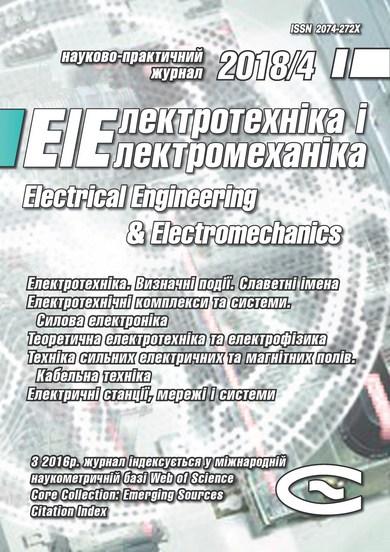CORRELATION BETWEEN ELECTRICAL AND MECHANICAL CHARACTERISTICS OF CABLES WITH RADIATION-MODIFIED INSULATION ON THE BASIS OF A HALOGEN-FREE POLYMER COMPOSITION
DOI:
https://doi.org/10.20998/2074-272X.2018.4.09Keywords:
halogen-free composition, radiation modification, irradiation coefficient, mechanical and electrical characteristics, correlation coefficientAbstract
Introduction. The high saturation of the cable routes of nuclear and thermal stations, wind parks and solar power plants, on-board systems imposes stringent requirements in the field of fire safety of cables, which makes it necessary to use highly flame retardant halogen-free compositions. The introduction of flame retardants causes the mandatory modification (crosslinking) of the polymer matrix. Purpose. Determination of the optimal radiation dose based on the correlation between the mechanical and electrical characteristics of a radiation-modified halogen-free ethylene vinyl acetate copolymer with high-strength flame retardant insulation cables. Methodology. Mechanical and electrical tests of samples of radiation-modified cables with a copper conductor cross section of 1.0 mm2 and a halogen-free filled insulation based on an EVA copolymer with a thickness of 0.7 mm have been performed. Results. A strong correlation is established between the elongation at break and the tensile strength, between the insulation resistance and the breakdown voltage. It is shown that at the optimum value of the irradiation coefficient in the range from 7 to 5, the insulation resistance increases more than twice, and the breakdown voltage at the direct current is increased by 1.3 times. The elongation at break is within the allowed values.References
1. IEC 60092-359:2014. Electrical Installations In Ships – Part 359: Sheathing Materials For Shipboard Power And Telecommunication Cables By IEC TC/SC 18A. 50 p.
2. Standard IEC 5444-4. Guide for determining the effects of ionizing radiation on insulating materials. Part 4: Classification system for service in radiation environments. 1986. 22 p.
3. ClelandM.R.High Power Electron Accelerators for Industrial Radiation Processing of Polymers. Hanser Publ., Munich and Oxford University Press. New York, 1992. 23 p.
4. Studer N. Electron beam crosslinking of insulated wire and cable: Process economics and comparison with other technologies. International Journal of Radiation Applications and Instrumentation. Part C. Radiation Physics and Chemistry, 1990, vol.35, no.4–6, pp. 680-686. doi: 10.1016/1359-0197(90)90296-t.
5. Finkel E.E., Leschenko S.S., Braginsky R.P. Radiatsionnaia khimiia i kabel'naia tekhnika [Radiation chemistry and cable technology]. Moscow, Atomizdat Publ., 1968. 313 p. (Rus).
6. Machi S. Role of radiation processing for sustainable development. Emerging applications of radiation processing, 2004, Vienna: IAEA. (IAEA-TECDOC-1386), pp. 5-13.
7. Zimek Z., Przybytniak G., Nowicki A., Mirkowski K., Roman K. Optimization of electron beam crosslinking for cables. Radiation Physics and Chemistry, 2014, vol.94, pp. 161-165. doi: 10.1016/j.radphyschem.2013.07.005.
8. Bezprozvannych G.V., Nabokа B.G., Morozova E.V. Radiating resistance of common commercial cables of internal laying. Electrical engineering & electromechanics, 2006, no.3, pp. 82-86. doi: 10.20998/2074-272X.2006.3.16. (Rus).
9. Bezprozvannych G.V., Naboka B.G., Morozova E.V. Change in the mechanical properties of materials of structural elements of optical cables under the influence of radiation. Bulletin of NTU «KhPI», 2004, no.7, pp. 28-35. (Rus).
10. Bezprozvannych G.V., Morozova EV, Sokolenko A.N. Effect of ionizing radiation on the capacitance and tangent of the dielectric loss angle of network cables. Bulletin of NTU «KhPI», 2003, no.9, vol.4, pp. 3-8. (Rus).
11. Berejka A.J. Radiation response of industrial materials: Dose-rate and morphology implications. Nuclear Instruments and Methods in Physics Research Section B: Beam Interactions with Materials and Atoms, 2007, vol.261, no.1–2, pp. 86-89. doi: 10.1016/j.nimb.2007.03.097.
12. IEC 60811-2-1:2001. Common test methods for insulating and sheathing materials of electric and optical cables – Part 2-1: Methods specific to elastomeric compounds – Ozone resistance, hot set and mineral oil immersion tests. – 32 p.
Downloads
Published
How to Cite
Issue
Section
License
Copyright (c) 2018 G. V. Bezprozvannych, I. A. Mirchuk

This work is licensed under a Creative Commons Attribution-NonCommercial 4.0 International License.
Authors who publish with this journal agree to the following terms:
1. Authors retain copyright and grant the journal right of first publication with the work simultaneously licensed under a Creative Commons Attribution License that allows others to share the work with an acknowledgement of the work's authorship and initial publication in this journal.
2. Authors are able to enter into separate, additional contractual arrangements for the non-exclusive distribution of the journal's published version of the work (e.g., post it to an institutional repository or publish it in a book), with an acknowledgement of its initial publication in this journal.
3. Authors are permitted and encouraged to post their work online (e.g., in institutional repositories or on their website) prior to and during the submission process, as it can lead to productive exchanges, as well as earlier and greater citation of published work.





